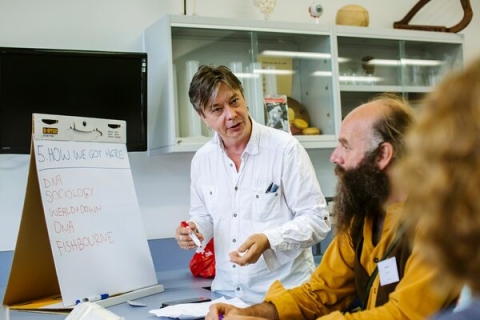

Connecting our modern world to long lost populations in surprising ways
Necromancy is the magical art of communicating with the dead. Over the past 35 years modern science has developed its own form of necromancy; the analysis of DNA recovered from bones of long dead people and animals. Much of who we are is determined by our DNA, from physical characteristics to our preference in flavours, it is becoming increasingly clear that our genes play a significant role in defining us as individuals. Furthermore, as DNA is passed down to us from our ancestors, we can connect our modern world to long lost populations in surprising ways.
The technologies for analysing DNA from living individuals is well established and promises to revolutionise health care. However, analysis of DNA from individuals hundreds, and sometimes thousands, of years old presents new problems for the technology. While we are alive our DNA is constantly repaired by our cells. However, when we die these repair processes cease. Although DNA is a robust molecule, which can survive for tens of thousands of years, it becomes broken up and accrues damage like an old book becoming increasingly smudged and faded with time.
Inside the cells of our body we have two types of DNA, mitochondrial and genomic, of which genomic provides the bulk of the human ‘blueprint’. However, mitochondrial DNA survives much better than genomic and importantly is only transmitted through the maternal line. This makes it an excellent choice for tracing back an individual to older populations. A common experiment would be to extract the mitochondrial DNA, amplify a small sequence called the hypervariable region within the mitochondria, and then read that sequence by Sanger Dideoxy sequencing. Although this has formed the backbone of ancient DNA study for 30 years, we now have access to new technologies that enable us to look at the entirety of the genomic DNA in one go – all three billion letters of it! Such approaches allow us to generate unprecedented information about long dead individuals from just small amounts of bone that may have survived the long ages.
In a modern, cutting edge, ancient DNA experiment DNA would be extracted from a bone, ideally the densest bone available, such as the petrous bone in the inner ear. The DNA is extracted in ultra-clean laboratories to avoid contamination and then used to construct what is referred to as ‘libraries’. These libraries are millions of distinct DNA molecules which, taken together, cover the whole of the genome. Each sequence in the library is tagged with a special bit of DNA that will enable the eventual sequencing step. Once the library has been built we need to fish out those sequences which correspond to human. The ‘smudging’ of the DNA over time means up to 99% of the library can be useless, so we need to isolate only those bits of the library that are still in a good state of repair. This so-called baiting step is critical, time consuming… And often goes wrong! Once successfully baited, the DNA is then read using Next Generation Sequencing (NGS) machines which can sequence many bits of DNA at once in a massively parallel manner. The NGS machines generate far too much data to be analysed by eye, so powerful computational clusters are required to analyse the data and create a genetic profile.
One of the most profound discoveries of whole genome sequencing of ancient DNA was the work of Svante Pääbo at the Max Planck Institute, who has conclusively shown that many of you reading this (including the author) have 3-5% Neanderthal DNA hiding in your genome; the results of an ancient cross-breeding between an ancestor and a Neanderthal. A discovery that not only rewrote the textbooks but also changed how and what we define as human. As technology advances and we continue to advance the science, we can further explore the world of our long-since dead ancestors. Who knows how the history of the world may be rewritten in the future?
